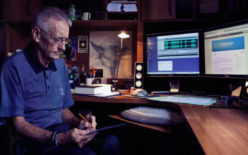Recently, a 9-11 researcher posted this article, “The 90-Minute Stand Down on 9/11: Why was the Secret Service’s Early Request for Fighter Jets Ignored?” My initial instinct was to let my article on the Andrews fighters stand and not comment. However, it later occurred to me that the article has considerable utility because it tells the beginning of the Andrews story, something I did not do in my article. However, the author has the thesis backwards.
Standing Down or Standing Up?
It is intuitively obvious that there cannot be a stand down without a preceding stand up. What the author actually reports are early attempts to stand up the Andrews fighters. He reports conversations involving staff officers at four locations; the Secret Service, FAA Headquarters, Andrews Tower, and the fighter wing, itself. The only actionable conversation is the one between the late General Wherley and the Secret Service. General Wherley, however, was not a battle commander that morning.
In other articles we have talked about the battle commanders; Ben Sliney and Colonel Bob Marr. None of the conversations referenced in the article involve either person or their staffs. Nor do they involve the only other organization that could take action, the NMCC. It would not have made any difference, the Andrews fighters were not relevant to the nation’s air defense that day.
Roles and Missions
We have gone over this before. The only organization with the air defense mission was NORAD. The only assets performing the role were four dedicated fighters, two at Otis and two at Langley. Andrews was never seriously considered for good reason.
Major Chambers summed up the NMCC perspective; the Andrews fighters were not part of the air defense system and not available. NEADS never considered the Andrews fighters because the Andrews Wing did not have the tactics, techniques and procedures in place to perform the role. Moreover, they did not carry authentication tables, according to the pilots the Commission Staff interviewed.
Further, NEADS had the New York and DC skies covered by its own fighter assets. Concurrent with the conversations referenced in the article, Colonel Marr started his own search for additional assets, but his focus was on the Midwest. The only additional threat of which he was aware was D 1989. NEADS had no immediate need for the Andrews fighters.
The Critical Moment
A few minutes after 9:30 Danielle O’Brien and her supervisor sounded the alarm about the fast approaching unknown (AA 77). Shortly thereafter, and in part because of the preliminary conversations referenced, General Wherley took action, prompted by the Secret Service. Even so, he wanted to hear from someone higher up in the food chain than the person calling him.
Concurrently, NEADS was redirecting the wayward Langley fighters and followed that redirection with a declaration of AFIO, Authority For Intercept Operations. The Langley fighters established a combat air patrol over the nation’s capital at 10:00, 36 minutes from time of scramble.
Standing Up Andrews
It should come as no surprise to anyone familiar with the roles and missions of the United States armed forces why the Andrews fighters were never a factor and were not tasked by the military chain of command that morning. They could not, and demonstrably did not, respond in any meaningful time frame. To do so was beyond their capability.
That is not a knock on the Andrews Wing, their personnel or their pilots. They worked diligently to get assets airborne, once tasked. It took them over an hour to do so and that was as fast as they were going to be able to do it under any scenario that day.
Correcting the Math
The referenced article headlines a 90-minute stand down. Assuming that the clock starts about 9:05 the activities described became actionable by 9:35 when General Wherley was directly tasked by the Secret Service. The implied 90 minute stand down was actually a 30-minute prelude to a concerted Andrews effort to get fighters in the sky, to stand up. The best they could do was to launch a single sortie over an hour later; a pilot with virtually no fuel, no armament, and no authority.
A Final Comment
I appreciate the author’s initiative and effort. He provides specificity concerning staff level discussions about protecting the nation’s capital in the immediate aftermath of the impact of UA 175 and the FAA’s determination that Atta said, “we have some planes.”
And a Postscript
The Washington Post, shortly after release of the Commission Report, published an editorial cartoon that portrayed the USAF and the Secret Service ‘Air Force’ butting heads in the sky. I have not been able to find a link to that prescient cartoon.
